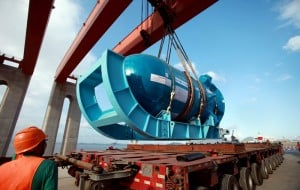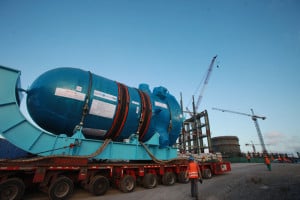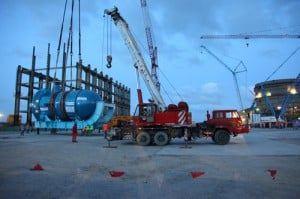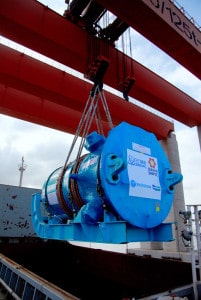Photos of Sanmen 1 pressure vessel arrival
The pressure vessel for Sanmen unit 1, which will most likely be the world’s first Westinghouse AP1000 in operation, arrived on site in late July. I thought you might like to see some photos of the component.
One thing that never ceases to impress me is the fact that the pressure vessel fully contains the nuclear reactor core, where all of the 3300 or so MW of thermal energy will be produced for the 1100 MWe power plant. The compact nature of nuclear energy become more understandable when you think of it that way. There is a whole lot of other machinery involved in converting that heat into useful electricity in a safe and reliable manner, but just think of having the fuel needed for electricity for 1,000,000 people for 18-24 months being stored in that little volume.





It’s a shame there won’t be one of those heading to America for at least several more years.
But a purchase order will go out in 2011.
Daniel,
One must try to remember that a purchase order is worthless until the purchased item/assembly is up and running!
The worse thing is that it is NOT even leaving USA to go to Korea and will not be made in USA when we buy one. It is (will be) stamped – “Made in CHINA”
Very nice pictures, Rod – thanks a lot! I too am always fascinated by the same thing you detail, and I in particular find the whole process of vessel and head fabrication fascinating. I agree it’s shameful that this isn’t “Made in the USA” and I wonder what the largest vessel we can still make here is. Doesn’t Babcock & Wilcox still have its Mount Vernon plant?
I’m guessing the mPower’s vessels will be proudly “Made in the USA”. Rod could likely confirm that.
Yup
Rod – thanks for the pictures. To me, the most impressive thing is that this small volume is a 3.3 GW thermal power source. My understanding is that other reactors types (IFR, LFTR, and others) have similar power to volume ratios. It seems a shame to operate such a powerhouse at a temperature that limits its thermodynamic efficiency to 33%. But then it’s still a great thing to see a nuclear reactor actually being built; I’ll take it… 😉
AP1000 nuclear reactor design deemed safe by the NRC staff http://www.power-eng.com/content/pe/en/articles/2011/08/ap1000-nuclear-reactor-design-deemed-safe-by-the-nrc.html
08/09/2011 The U.S. Nuclear Regulatory Commission said the design of Westinghouse C…
I’d like to know some basic stats about this amazing part. Does anyone know how much it weighs, height, width? How long did it take to forge and machine?
I am thinking it is on the order of about 400 tons.
Here’s a link to a wall chart for it’s predecessor, the AP600, which I don’t think ever got built. Other wall charts from this site contain some of the stats you are interested in.
http://econtent.unm.edu/cdm4/item_viewer.php?CISOROOT=/nuceng&CISOPTR=107&CISOBOX=1&REC=4
A similarly-sized Westinghouse reactor design from Generation II of nuclear power plant design has an inside diameter of 173 inches and an inside height of 495 inches according to its wall chart.
http://econtent.unm.edu/cdm4/item_viewer.php?CISOROOT=/nuceng&CISOPTR=68&CISOBOX=1&REC=6
@ Jason C
Here’s a site with some wall charts of various nuclear power plants where you could find some of those stats.
http://econtent.unm.edu/cdm4/browse.php?CISOROOT=/nuceng&CISOSTART=1,1
This AP1000 Reactor Vessel is likely somewhat close to the same size as the Reactor Vessel for Sequoyah, which is reactor number 55 at the link above.
What a shame that China appreciates Westinghouse and its AP-1000 more than the USA does. With the experience they will gain by operating modern NPPs they will develop improved designs to sell far and wide.
Meanwhile in the USA we talk a great deal but don’t do very much, so our “fleet” of NPPs will soon transition from obsolescent to flat out obsolete
Well, I am sure that you know the U.S. is currently building two new reactors in Georgia which are the AP1000 design, also a couple more in South Carolina. These two facilities construction cost and ultimately the outcome will decide if the U.S. will continue with NP.
Kyle,
The decision as to whether the US will continue with nuclear power is not contingent entirely on the performance of the AP1000 projects.
There are also TVA’s Watts Bar Unit 2 completion and probable Bellefonte Unit 1 completion (decision to be made at August 18th TVA board meeting) projects whose performance will play a role, and then an even bigger factor could be the introduction of SMRs.
Since electricity demand growth in practically every region of the U.S. is unlikely to ever be sustained above 3 percent annually for any future period of longer than 2 consecutive years, the massive nuclear plants that have been the norm historically are not going to fit the load growth needs of U.S. utilities (except for maybe a few exceptions). With the impending smart grid technologies and the concerted conservation efforts that have become ingrained in our American minds, the U.S. electricity market is already too saturated with capacity at this point to necessitate too many massive generating capacity additions in the future.
Thus, the incremental addition of smaller, modular units will be much more fitting both for “natural” load growth and for most of the replacement capacity that will be needed for the retiring of older generating units.
We shouldn’t take such a narrow view. We should be thinking in environmental terms, in other words phasing out coal burning plants and replacing them with nuclear.
Right, David, but the oldest of the coal plants will be the first to be replaced.
TVA has already announced plans to close down 18 coal-fired Units in coming years. That generation is going to be replaced by Watts Bar Unit 2, (likely) Bellefonte Unit 1 (with that “likely” caveat being gone 1 week from yesterday), and hopefully by the initial installation’s of mPower reactors at the Clinch River site.
Many utilities don’t have a financial structure that is presently conducive to building nuclear plants, but that will change when (not if) natural gas prices rise again. My guess is that a lot of utilities are going to feel somewhat silly for not getting their nuclear balls rolling sooner.
The Chinese “C”AP1400 is already planned and construction of a prototype is scheduled for 2013 (uprated power to 1400 MWe).
Now is an excellent time too with an excess of labor and low interest rates. Seems like there are two traditional supporters of the Democratic party that working against each other with respect to the delays of these projects. On one hand, the unions are probably in support of all the additional union-type jobs while on the other hand the trial lawyers make out well (on both sides) if the litigation continues indefinitely.
I hea ya john, just let the unions bleed them dry.
@Kyle – do I detect a bit of anti-labor attitude in your comment?
Some of the strongest supporters of new nuclear power plant construction are labor unions. They want the excellent jobs and benefits that come with both the construction of the plants and the later operations and maintenance of those plants. The Vogtle project, for example, will employ as many as 4,000 people on site (plus a large number of engineering and manufacturing employees who may never see the site) for about 6 years. When operating, the two reactors will probably need a continuous work force of approximately 800 people, with periodic spikes to several thousand during outages.
Some businessmen get scared by those numbers, but they forget just how much money they will be saving on fuel and the infrastructure required to properly treat the enormous stream of waste products that is an unavoidable result of burning hydrocarbon fuels.
While unions can be an obstacle if the relations between labor and management deteriorate, they can be a huge source of the political support needed to allow the projects to proceed in the first place. The key is respect, sharing, and cooperation to allow working people to benefit from the project while not becoming obstacles to project completion like they were in very specific cases at places like Shoreham, where there was a dicey relationship between mob influenced unions and an incompetent group of managers.
Look at the number of NPPs on hold in that link. If you want to reduce CO2, think of how many coal plants could be scrapped if these were built. Think of how many jobs there would be building these – Most high paying. And each would create a lifetime of employment for about a 1000 people – just at the plant! – that many more on the surrounding area.
As I responded to an anti today, carping about the AP-1000 licensing, who regurgitated like a Pavlov dog, “what to do with that pesky waste?”
>>>Actually, that “waste” is a potential energy mine of staggering proportions.
Properly separated and recycled by a scientifically-advanced nation not hobbled by media-amplified radiophobia, it could be used to power cities, provide lifesaving radioisotopes for cancer treatment, and sterilize food-borne toxins by harmless gamma irradiation.
When the historians look back twenty years from now to parse the factors that swapped superpower status between China and the United States, they will see that the former’s pragmatic embrace of atomic energy, and the latter’s witless rejection of it, played a major role.
The only “disasters” where there are no casualties seem to be “nuclear disasters”. You need to find a bigger word then for when someone is actually killed, like in a car crash.<<<
how you get those shots? you stay there? it takes lots of efforts,nice work!